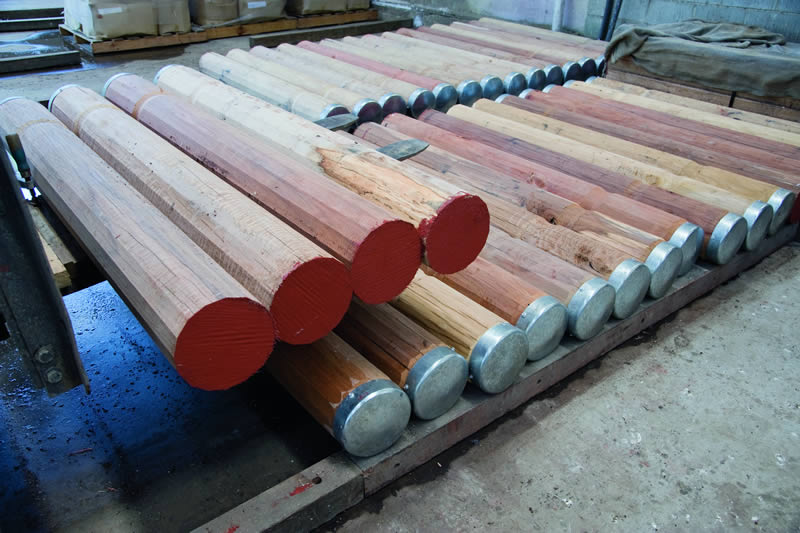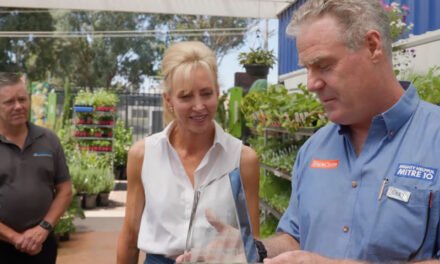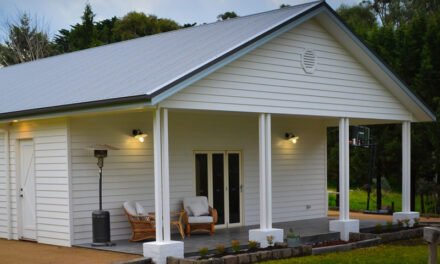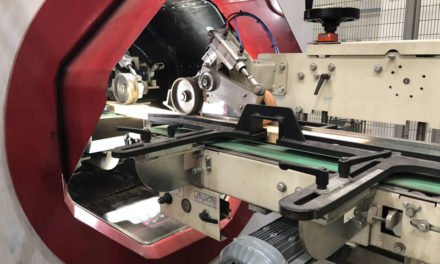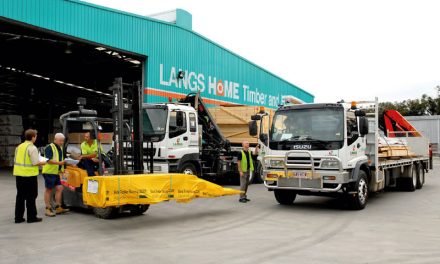From delivering electricity to keeping the cows in and the wine grapes up, posts and poles are everyday essentials and their suppliers face some unique challenges.
You’d be hard-pressed to go for a walk without encountering round timber products, whether as poles delivering electricity, fence posts, in kids’ play areas or one of their hundreds of landscaping and agricultural uses. Yet their very ubiquity sees them discussed less than sawn timber.
Which is a shame, because while some aspects of the market haven’t changed since humans first started building with logs – straight, branchless trunks are still what you want – other aspects of the sector, from delivery to sizing and even treatment have exciting new developments.
We spoke with suppliers including retailers, wholesalers and treatment plants about what they’re bringing to the market and how that market is developing.
Powering on
About 40% of Coffs Harbour Hardwoods’ business is made up of round wood products, particularly power poles. “It’s a fairly consistent income stream for us,” says Ryan McCarthy, the company’s sales and marketing manager.
The tree selection for poles is a bit different to sawn wood: long and straight is the priority, with a trunk free of limbs. There is a rigorous inspection process to make sure the timber meets the specifications laid out in the Australian Standard and by the electricity companies that are the main customers. “These products are generally supporting pretty important infrastructure, so the timber we use needs to be of the highest level of strength and durability and contain a minimal amount of natural defects,” says McCarthy.
The multi-stage inspection includes attaching individual information to each piece, ranging from pole length and kilonewton strength group to a small metal disc inserted into each pole for identification and traceability purposes. Gang nails at the base (see cover) add an extra guarantee against splitting. “We supply the cross arms, too,” says McCarthy. “They’re usually supplied pre-drilled, so we have all the different drilling patterns for the different power companies.”
Raw logs are generally treated with CCA to H5 (the AS requirement for poles exposed to in-ground severe wetting conditions) or de-sapped for use in rail networks, which prefer to use untreated poles. The de-sapping process requires an initially larger-diameter log, which has its sapwood planed away, leaving the durable heartwood.
“All our CCA treatment and de-planing is done onsite at our facility in Glenreagh,” says McCarthy. Coffs Harbour Hardwoods also offers an ACQ treatment for certain round wood products such as landscaping to H4 level. This is done offsite. “This process requires us to organise the product to be freighted to and from the contractor as well as fit in with their availabilities,” he adds, “So it adds a layer of complexity to the logistics.”
Poles provide a solid income stream for the Coffs team, but they have to work for it.
“The major electricity power supply companies are our main customers and their requirements are pretty standard,” McCarthy says. “Meeting them is sometimes less so. They like smaller poles, because they cost less and are easier to move, however, after the bushfires, they’re in short supply, so they’re taking bigger sizes now.”
Supply is an ongoing challenge: specific sizes are in high demand, as well as the affects of wet weather, bushfires and supply agreements also needing to be juggled.
“We tender for the power poles and those contracts usually last around five years,” McCarthy says. “This gives us a bit of scope to be able to forecast how much raw material we need to obtain, based on usage requirements provided to us. And we have a very large location, which gives us space to store our stockpile while it’s seasoning and make sure we have enough in hand for each customer’s specifications.
“To procure our resource, Forestcorp NSW send in round wood for poles, based on where they are harvesting at the time and you’ve just got to take what’s offered. One other issue we’ve had to deal with relating to this is the current wood supply agreements. The wood supply agreements (WSA) end in 2023, Forestcorp NSW have not decided yet how they are going to allocate timber resources to the industry after 2023. This makes it very challenging to plan ahead.”
Delivery comes with its own set of challenges. “We often go into some pretty remote locations in regional NSW,” says McCarthy. “They can be four hours from the nearest town of reasonable size with a forklift or crane that can unload. We’ve bought crane trucks that can self-unload the poles at the depots and then just drive straight back. In years gone by, we’ve had trucks waiting a number of hours for a crane to arrive, which throws out the rest of the week’s schedule, so it’s worth it!”
Additional products include a wide range of bollards, marine piles (treated to H6) and landscaping poles. “That includes fauna poles,” McCarthy says. “They’re erected along highways with rope high across the road from one side to the other for possums and other animals to use and stay safe.”
Agricultural specialists
When Valerie Heywood of Gippsland Treated Pine started the business with her father Bruce in 1992, it was purely a round post business. Over time, they’ve diversified into other timber products, but they still carry an enormous range of posts and poles, with staple stock covering the core agricultural-needs range from 1.8–6m high and 50-250mm diameters.
“It’s still about half the business,” says Heywood. “The farmers are always there, especially dairy and beef. There was a booming ostrich industry for a while, so everyone was making 3m-plus posts for the ostrich fencing, but that’s all disappeared. Before that there was the deer.”
While farming fads evoke a wry smile, Heywood has met them all. “We can respond pretty quickly to whatever the trend is: if there’s a demand for it we just make a different size or length post,” she says.
Being integrated into the agricultural trends of the region helps Heywood and her team somewhat when it comes to forecasting demand. And with the company’s head office in Morwell and sites in Bairnsdale and Beaufort, there’s a lot of space for the various plants and processes offered by Gippsland Treated Pine. All their round post products are treated with CCA or ACQ.
“The ACQ is seen as more environmentally friendly,” Heywood says. “They’ll order it if the product’s going to be in frequent contact with children, in playgrounds or environmentally sensitive areas, but the farmers mostly stick with CCA, because the kids aren’t out in the paddocks playing with the posts. They do choose ACQ for their decks – it’s mostly sold for domestic and landscaping use.”
Running their own treatment plant is helpful when it comes to costs – the margins aren’t huge – but it’s particularly helpful for managing stock levels. “We season most of our timber naturally over five or six months, so at any time we’ll have some raw at various stages of seasoning and some treated in the yard. If we get a specific order in, we can treat the raw to the hazard level it requires. Normally your farm fencing is H4, but some people need H5 or H6 and being able to do it on site allows us to manage orders efficiently, especially if we get a big, unexpected order.”
Gippsland has a steaming plant at its Beaufort site where timbers can go straight from the sawmill to ready for seasoning in a fortnight, so special orders can be fulfilled more quickly. “We can’t always predict what’s going to come in as orders, and if you get a big one, that can be all the stock you have of one size. This year’s particularly impossible to predict!” Heywood says, laughing.
Like McCarthy, she’s seen issues with supply become more difficult over time. “The resource just isn’t there,” says Heywood. “Foresters went through a phase where they planted a lot of blue gum and not as much radiata so you had gaps there, and then a lot goes to export, which means there’s less opportunity for local businesses like ours to buy preservation wood.”
Posts use smaller timbers, the first and sometimes second thinnings of plantations, cut at around 15-17 years. Recently, more of that timber has gone into paper and pulp products, which creates an additional supply pressure. But that’s not the only challenge Heywood and her team has faced.
“In the past, farmers would buy their posts when the grounds got soft and they were able to drive them in easily, before the rains came in the paddocks,” Heywood says.
“But the seasons are so unpredictable now. We used to sell our posts mostly across three or four months of the year, now we’re starting in March and going right through to October. Farmers can’t trust the weather these days. They used to do fence repairs in between crops, but now it could be drought, flood, fire… it’s really difficult to predict what people will need and when they’ll want it, that’s our biggest issue.”
Increasingly long and bad bushfire seasons are also causing problems. The steel industry has long sought to take a bigger share of the fencing sector and use fire risk as a major selling point. “It’s a very large business and extremely well-funded and influential,” says Heywood. “When they promote the use of steel posts in fencing, it really impacts on the timber industry. I can see that making things really difficult in years to come, even though it’s not the risk-free product they allege.”
For now, Gippsland Treated Pine is still doing well, but Heywood has hedged her bets: “I make sure we carry a variety of products: we sell hardwoods, cypress and other species, and all sorts of other products, so if the farmers are struggling and the post season is quiet, the others will keep us going. It’s just a matter of being versatile.”
Wholesale production
An hour’s drive away, in South Gippsland, treated posts are the mainstay of Alberton Timber’s business. Founded by John Olarenshaw and his son Luke in 1992, the company focuses on the agricultural wholesale market.
“About 90% of our sales are rounds going to agricultural supply stores,” says Luke.
“We’ve processed round wood on site from the start of the business in 1992, but we’ve focused on branching into the wholesale side of things over the past 10 years, because it fit the market in our area.”
Logs are sourced from HVP Plantations Gippsland and processed on site, then steam-dried and treated. “Each of those is a value-add for us to help us with our margins, but because it is such a high-processing product, the margins are pretty tight,” says Angela Olarenshaw, administration manager and Luke’s wife. “In 2013, Luke and John put the first steamer in, which allowed us to steam dry over a 14-day period as opposed to air drying over six months, so that’s allowed us to keep up with the larger orders in wholesale. Before that, we couldn’t get the timber dry quickly enough and we had to hold stock for a lot longer.”
Alberton offers a comprehensive range of H4 treated rounds, from 1.8m to 6m and 75-100mm to 200-225mm diameters.
“Most of what we sell is the 4-5 inch,” says Luke, using the Imperial measurements posts are still often sold under. “It’s 75% of our sales, but it’s getting harder to keep up with demand. Every processor in the country can’t produce enough at the moment and nearly every one would be in full production. This is the best I’ve seen it in a long time.”
Decent rains and good farm prices have invigorated the region, which has had one of its best years in the past 20, leading to Alberton installing a second steamer and building a completely new post peeling plant.
“We’re three-quarters of the way through building a whole new mill, so we can have a safer, more productive processing plant,” says Luke. “That’s a pretty good place to be for a small business. Our growth this year has been a 42% increase in sales, year-on-year for the March quarter. So we’ve been running flat-out at the same time as trying to oversee the new build, which is mostly being done in-house. A bit of a hectic year so far!”
Completion on the build is scheduled for the end of September, depending on how busy the Alberton team is. “We were lucky enough to get a business and innovation grant through the Australian Government’s Regional Jobs and Investment Packages to help fund those works,” says Angela. “We wouldn’t have been able to do it without that. It’s been interesting undergoing major expansion at the same time as all this uncertainty happening in the world, but it’s going OK. Usually the January to March quarter is one of our quietest, but it’s been really busy this year.”
Farm confidence aside, the Olarenshaws have seen a few changes in buying patterns around their region. Larger diameter posts have become more popular, though no one’s sure why, and overall demand has surged.
“We saw that after the big fires up in East Gippsland,” says Luke. “A lot of farms were hit hard and have been rebuilding.”
The onsite treatment for round wood products is all CCA. “We’re looking at moving into other processes in the future,” says Luke. “I’ve been considering MicroPro or another ‘eco’ process, because we do have queries from organic operators who don’t want the CCA, but they’re a very small percentage. We used to run an ACQ treatment for them on our rounds, but the demand just wasn’t there. Most people buy rounds straight off the Australian Standard, so H4 for in-ground product. Their main focus is cost, it’s a very price-driven industry.”
Angela points out that some of their customers are happy to promote a locally owned and run supplier, and Luke agrees.
“A lot of our competitors are big companies and we’re just a small family business, which means a lot to people,” he says. “We work hard to be worth that support. Meeting big orders can be very tough, which is why we’re doing our upgrade. With the new upgrade, we’ll be able to offer different products, such as precision rounds and Cambio posts in addition to the Morbark shaved posts we produce now, so hopefully that will open up new markets for us again.”
Revolutionising treatment
While CCA is a reliable staple for round wood treatment, it has limitations beyond not suiting farmers with an eco bent. Not only does it release toxic fumes when burnt, the heavy metal component makes it burn hotter and longer, making it more likely the whole post will be destroyed in a fire. Add to this limited disposal options for CCA product at end of life, which often mean expensive landfill costs or onsite storage.
Lonza Wood Protection has long researched more environmentally friendly methods of preserving timber and has recently brought a new product to the agricultural round wood market: Tanalith K Wood Preservative. A fire-resistant, metal-free preservative for H3 to H5 treatment, it also delivers improved appearance, handling and odour over traditional creosote and has a cradle-to-grave useful life cycle.
A long testing process for the product has shown it can be used in a conventional water-borne treatment plant at ambient temperatures with very few modifications required, which means a fast and cheap conversion process for processors who choose to change.
“We converted the existing Miland Nominees CCA treatment plant in SA to run a limited period trial with the new water-borne creosote preservative,” said Lonza regional director Angelo Hrastov. “A number of our Australian and New Zealand customers provided timber and visited the site to inspect the process and treated timber.”
Trial results with both steamed and air-dried posts showed excellent product penetration and uptake control. The process is now in commercial production for treated pine posts, marketed as Tanapost wood products, by Mt Gambier’s Roundwood Solutions.
Stephen Telford, managing director at Roundwood, has invested $7 million in the new facility. “We make a lot of wood being the ultimate renewable, and that comes with a responsibility to have a circular business model,” he says.
Telford points to costs of mopping up waste from the fires at Cuddlee Creek this year. “I’ve heard it’s cost the SA government a million dollars to dispose of the burnt treated CCA posts. So there’s a big incentive for the EPA and regulatory authorities to look at an alternative like Tanapost where the end of life cost is basically zero. Those fires also went through a vineyard, leaving toxic ash through the growing area. All that had to be collected and taken to approved landfill for disposal – a big cost to the viticulturalists.”
Part of Telford’s investment has been a boiler imported from the US, where broken and scrap Tanaposts can be burned for energy recovery. “It’s currently installed and driving our steamer,” he says. “In the future, we’ll be installing a modular add-on and the energy from the posts will then go towards our electricity use as well. And once we get EPA approval, we’ll be able to take posts back from our customers.”
The posts burn cleanly, meaning even the water in the steamer can be recycled. Though it does take some effort to get the posts to a temperature where they will ignite. Tanapost wood products are inherently resistant to fire, and with no metal content, it has no ‘afterglow’ effect. In a normal bushfire, once the fire front goes through, the post is self-extinguishing, leaving just a layer of char on the outside of the post.
Installation methods are the same as CCA and high-temperature creosote (HTC) posts, both of which are mainstays of the sector.
Fencing contractor Paul Bellinger, from Beachport, SA, was one of Roundwood Solutions’ early customers for fence posts. He was intrigued by the product and admits: “I cut one in half and was surprised at the uniformity of treatment. They weren’t greasy to the touch like normal creosote posts and were easy to install.”
Telford isn’t surprised. “It’s a full-cell process, it goes all the way through,” he says. “The treatment process ensures good penetration while the emulsion system reduces the effect of weathering.”
For customers who are used to standard HTC product, Tanapost comes without the pervasive smell and spatter, and without their attendant handling and storage issues. At the higher treatment levels, the product is extremely competitive on price alone.
“Our business believes in driving this shift into a new system,” says Telford. “We’ve had positive responses from PIRSA And Green Industries SA. For wineries wanting a green stamp, it’s this, recycled plastic or steel. Unlike either of them, Tanapost is a carbon sink that helps to improve our environment.”
Telford is convinced Tanapost is going to be a catalyst for change in the industry. “We’re the first commercial plant in Australia – the world, really, but there’s the opportunity for this product to go all around the globe. We’ve had a good response so far, but it’s still early days. A lot of the market still buys on price, so we’re starting with the section that is open to buying on ecological benefits and then letting the product’s quality speak for itself.”
For more, visit www.coffshardwoods.com.au, www.gtpine.com.au, www.albertontimber.com.au, www.lonzawoodprotection.com/apac/ and www.roundwoodsolutions.com.au
Image: De-sapped landscape rounds. Courtesy Coffs Harbour Hardwoods.

